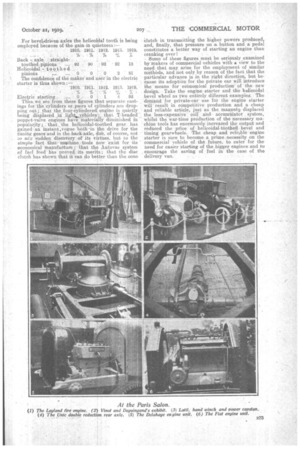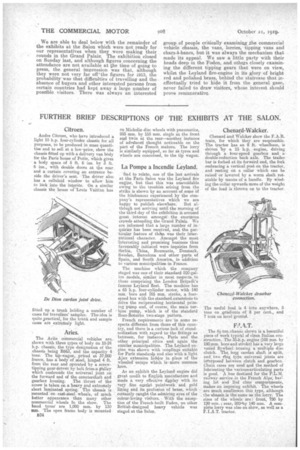PARIS SALON STATISTICS.
Page 10

Page 11

Page 12

If you've noticed an error in this article please click here to report it so we can fix it.
Some Figures Which Clearly Show the 'Trend of Motor Chassis Design and Point Some Useful Lessons.
THE FPBEIGN commercial vehicle exhibits at the Paris Salon were, of course; not so ekten•L sive nor did they show such a wide a,pplica-tion as Will he possible when the British Commercial Vehicle Show is held next spring. Our own-observations in and around Paris leads to the conclusion that the French are still a long way behind in their employment of motor power in commercial haulage, one of the reasons being the large amount of capital locked up in 'horses and 'horsed vehicles and the greater relative.resistance on'the part of the French to face heavy depreciation charges by "scrapping " out:of-date methods. The examples exhibited at the Salon showed the skill in engineering and designing for which the French and Italians are justly noted, but it would be going too far to ,say that the British designer had much to learn -from the foreign commercial vehicle exhibits. Hence ms,ny of the lessons of the Salon are to be extracted from the Show as a whole because in this way a linc of thought can be discovered and tendencies in design located-resulting. as must inevitably be the case in some measure,
in influencing design of commercial vehicles. • The well-known French authority on motor matters, Charks Faroux, has prepared a set of statistics which he eommeneed in the year 1910, and therefrom we extract certain figures which will greatly illuminate the position.
First of all taking the engine, we find that the growth of the single casting, or the casting en bloc, has proceeded rapidly, the figures being percentages of the total of the vehicles exhibited. The Mors band clutch stands as a single example of a system which does not appear in the above table. The Mors band clutch stands as a single example of a system which does not appear in the above table. For bevel.driven axles the helicoidal tooth is being employed because of the gain in quietness: Electric starting ... .0 0 1 4 92
Thuswe sec-from these figures that separate castings for the cylinders or pairs of cylinders are dropping. out..; . that the four-cylindered engine is quietly being _displaced in lighLvehieles-; -that T-headect poppet-valve engines have materially diminished in popularity,;., that the helicoidal-toothed gear, , has gained, art mstant.vogue both -in the drive for the timilig gears and in the .back axle, due, of course, not be Baty sudden. discovery a its virtues, but to the simple fact that machine tools now lexit for its economical manufacture that the Autovac system of filel feed' has proved. its merits ; that the disc clutch has -shown that it can do better than the cone
Clutch• in transmitting the higher powers produced, and, finally, that pressure on a button and a pedal constitutes a better way of starting an engine than cranking over
Some of these figures must be seriously examined by makers of commercial vehicles with it view to the need that may arise for the employment of similar methods, and not only by reason of the fact that the particular advance is in the right direction, but because its adoptien for the private car will introduce the means for ecenonaical production of the new design: Take the engine starter and the helicoidal bevel wheel as two entirely different examples. The demand for private-car use for the engine starter will' result in competitive production and a cheap and reliable article, just as the magnetg displaced the less-expensive coil and accumulator system, whilst the war-time production of the necessary machine tools has enormously increased the output and redueed the -price of helicoidal-toothed bevel and timing gearwheels. The cheap and reli,:.ble engine starter is sure to become a prime necessity on the commercial' vehicle of the future, to cater for the need for easier starting of the bigger engines, and to encourage the saving of fuel in the case of the delivery van. We are able to deal below with the remainder of the exhibits at the Salon which were not ready for our representatives when they were making their rounds m the Grand Palms. The exhibition closed on Sunday last, and although figures concerning the attendance are not available at the time of going to press, the general impression was that, although they were not very far off•the figures for 1913, the probability was that difficulties of travelling and the absence of 'buyers and other inteNsted persons from certain countries had kept away a large number of possible visitors. There was always an interested group of people critically examining .the commercial vehicle chassis, the vans, lorries, tipping vans and chars-à-bancs, but it was always the mechanism that made its appeal. We saw a little party with their heads deep in the Foden, and others closely examining the different tipping gears that were on view, whilst the Leyland fire-engine in its glory of bright red and polished brass, behind the staircase that ineffectually tried to hide it from the general gaze, never failed to draw visitors, whose interest should prove remunerative.
























